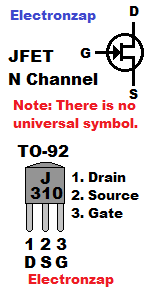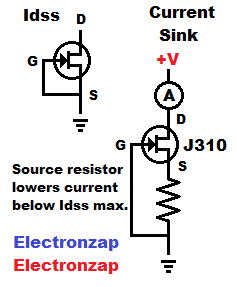Table of Contents

JFET transistor components make for an easy current source circuit fragment. Providing a certain amount of current that only varies a little bit over a range of voltages.
The only JFET I have is the N channel depletion mode J310. Therefore it is the one I use in my demonstration circuits.
According to the datasheet I looked at, the J310 has…
- Idss of 24mA to 60mA
- Maximum power dissipation of 350mW.
Idss and setting current:

Connecting both the Source and Gate pins of an N Channel JFET transistor to ground while the Drain is connected to the positive supply voltage, or to a load, will allow the transistor to pass it’s maximum current as long as there is enough voltage.
This is known as it’s Idss.
My J310 passes somewhere around 31mA of current while wired for it’s Idss, as demonstrated in the video below.
According to the datasheet I looked at, a J310 could have an Idss of anywhere between 24mA to 60mA. You have to test each one to know for sure what it’s value is.
0.03A x 5V = 0.15W of transistor power that needs to be dissipated for my J310 at 5V. Therefore I keep the voltage across my J310 to about 5 volts. Only exceeding it by a couple of volts for short periods of times.
Adding a resistor from the Source pin to ground lowers the current passed from Drain to Source below the Idss. In my video below, I used a 100Ω resistor, which sets the current of my J310 to about 10mA at 3-7V with no load and also about 10mA of current at 5-7V with a red indicator LED added in series on the drain side.
I got my J310 from the Joe knows electronics kit above. It has a nice assortments of semiconductors to learn about and experiment with. Amazon affiliate link ad.
- Become a Patron!
- My YouTube videos! https://www.youtube.com/c/Electronzap/videos
- Affiliate link products https://www.amazon.com/shop/electronzapdotcom
Make sure to subscribe and ring the bell! from r/ElectronicsStudy
- Information on this site is not guaranteed to be accurate. Always consult the manufacturer info/datasheet of parts you use. Research the proper safety precautions for everything you do.
- Electronzap is a participant in the Amazon Services LLC Associates Program, an affiliate advertising program designed to provide a means for sites to earn advertising fees by advertising and linking to amazon.com.